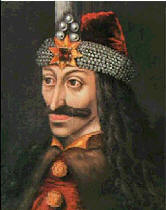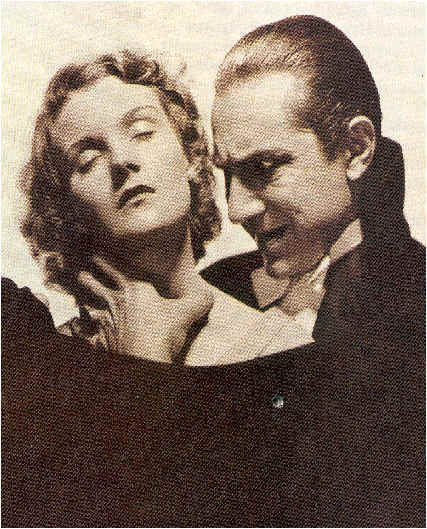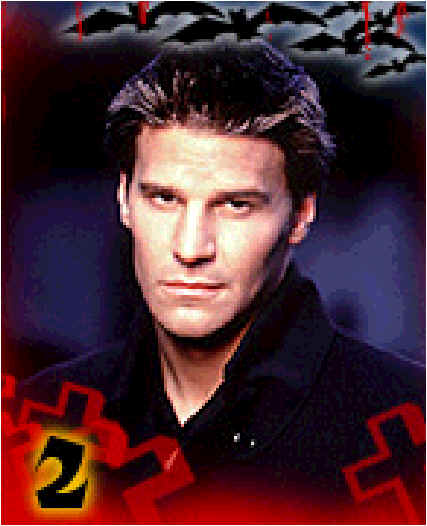|
|
||||||
|
Vampire noun (borrowed from French, borrowed from German Vampir, borrowed from Serbian vampir )
2):
one who lives by preying on others: a woman who exploits and ruins her
lover
3: VAMPIRE BAT
|
||||||
|
Vampire myths go back thousands of years and occur in almost every culture around the world. The variety of other-world bloodsuckers is almost endless — from red eyed monsters with green or pink hair in China to the Greek Lamia which has the upper body of a woman and the lower body of a winged serpent, from vampire foxes in Japan to a head with trailing entrails known as the Penanggalang in Malaysia. The vampires we are familiar with today, although mutated by fiction and film, are largely based on Eastern European myths, especially those of the Balkans and of course the Carpathian mountains, including Hungary and Transylvania. Our modern concept of the vampire still retains threads, such as blood drinking, return from death, preying on humans at night, etc in common with the Eastern European myths. However many things we are familiar with; the wearing of evening clothes, capes with tall collars, turning into bats, etc are much more recent inventions. On the other hand, many features of the old myths such as the placing of millet or poppy seeds at the gravesite in order to keep the vampire occupied all night counting seeds rather than preying on relatives, have all but disappeared from modern fiction and film. The idea of the vampire come from the observations of primitive man that loss of blood causes death. At least as early as 2000 BC they then deduced that the power of life rests in the blood— the life is in the blood. Genesis 9:4. Since death was caused by life leaving the body, and since the life was in the blood, they reasoned that if they could get the blood back into the dead body the person would come alive again. Unfortunately they were not able to pump blood back into the veins and they couldn’t get the corpse to drink any blood. None-the-less it was believed that dead souls could drink the blood and it would give them life, i.e. keep them from fading away entirely. |
||||||
|
In Homer’s Odyssey we read (Book 11) where Odyssus sought information from the ghosts in the land of mists, so he poured out blood into a trough which attracted the shades. He kept them from drinking of the blood until they revealed to him the information he sought. Perhaps if the dead got enough blood they could come back to life entirely or at least enough to be animate. Here we have the beginnings of the vampire myth—the dead coming back to life after drinking blood. In the early stories these living-dead were more spirit than matter. Like spirits, they could be invisible, they could fly, they could change form, and of course they needed blood to stay functioning. Being spirit, they cast no shadow and had no reflection in the mirror. They were obviously evil because they were transgressing the order established by God and they were killing people and drinking their blood. Since they were evil, they bonded with those things of night—wolves, bats, owls, rats and other animals and forces associated with darkness. And thus the vampire remained, more a cre |
 THE
REAL DRACULA was Vlad
Tepes or "Vlad the Impaler". A 15th century Romanian prince who was
famous for his acts of inhumanity and cruelty. Among his many
atrocities was his predisposition to impale the severed heads of his
enemies on stakes. He earned himself quite a bloodthirsty
reputation. He was referred to as Vlad Dracula and also as Son of
the Devil/Son of the Dragon (his father was Vlad Dracul). THE
REAL DRACULA was Vlad
Tepes or "Vlad the Impaler". A 15th century Romanian prince who was
famous for his acts of inhumanity and cruelty. Among his many
atrocities was his predisposition to impale the severed heads of his
enemies on stakes. He earned himself quite a bloodthirsty
reputation. He was referred to as Vlad Dracula and also as Son of
the Devil/Son of the Dragon (his father was Vlad Dracul). |
|||||
|
|
ature of spirit and night until he was given a new life by Bram Stoker in 1897.Stoker came across the name Dracula in a book he was researching entitled An Account of the Principalities of Wallachia and Moldavia (1820). This book has a very short section on a "Voivode Dracula" who fought against the TurksWhat attracted Stoker to the name "Dracula" was a footnote by Wilkinson which stated that "Dracula in the Wallachian language means devil". Not quite accurate, but that is is what Stoker saw and copied into his notes. He was originally going to call his vampire "Count Wampyr" but changed it to "Count Dracula." This change is clearly made in Stoker's own notes for Dracula which are located at the Rosenbach Museum in Philadelphia.The real Dracula (about whom we know much more than Stoker ever did) was NOT a Count, nor was he a vampire (or ever associated with vampires). The two Draculas have become greatly confused in many people's minds. In Stoker’s novel, Dracula possesses the following powers and supernatural traits: |
|||||
|
he is potentially immortal he survives on the blood of others he has the strength of 20 men he can shape-shift into the form of a wolf or a bat he can appear as mist or elemental dust he has no reflection in a mirror he casts no shadow he has hypnotic power over his victims he can turn victims into vampires
But he does have limitations: he must sleep on the soil of his native land he can cross running water only at the slack or the flood of the tide he is repelled by garlic and holy symbols (crucifix, holy wafer) he can be destroyed by driving a stake through his heart and by decapitation
|
 BELA LUGOSI, the most famous portrayer of vampires in films, is shown in a classical scene. The sexual implications are quite clear and probably have contributed greatly to the popularity of the vampire figure. |
|||||
|
Most of us are entertained by the vampires of print and film, but surely no one believes that Dracula is any more real than Cinderella? Yes, many people believe that vampires are real, and even admire them.Actually there are real vampires. One type of real vampire is an individual with a blood fetish – i.e. they get off on drinking blood or having someone else drink their blood. You can look on the web and find a website that over 100,000 people have visited that deals with real vampires. Of course, they have no special powers, though they are pale from lack of sunlight. Drinking blood does not make them immortal, in fact, it may shorten their lifespan. Most of these vampires can be found in various Goth groups. Many Goth women get off on letting a “vampire” drink their blood. It is usually a little licking, never an actual draining. There is nothing in Stoker's novel to indicate that the vampire can be destroyed by sunlight, though daytime, weakens him and reduces his supernatural powers. |
||||||
 ANGEL, played
by David Boreanaz, a popular vampire with several TV series ANGEL, played
by David Boreanaz, a popular vampire with several TV series |
Goth is short for Gothic, as in Gothic
novels like Frankenstein and Count
Dracula, which feature moody, pale characters with spooky
stuff happening to them. Goth culture entails vampire fashions,
gloomy, emotional music, and clove cigarettes.
Another type of
real vampire is a schizoid individual who THINKS he is a real
vampire. He believes he can form and will live forever. He
thinks he has the to become invisible. He is obviously insane
and is a danger to those around him, for he believes he must
drink the blood of others to maintain his power. This type of
vampire may become a favorite of Goths, those most of them know
they are only pretending and get put off by any one who is not
pretending.
|
|||||
|
||||||
